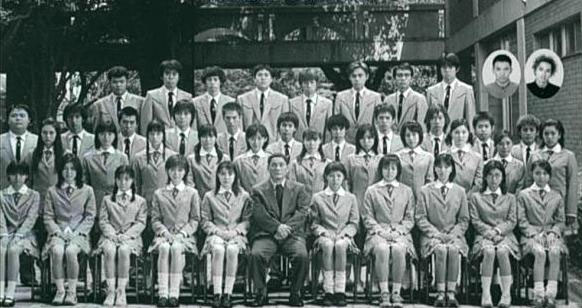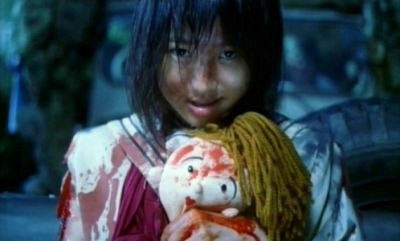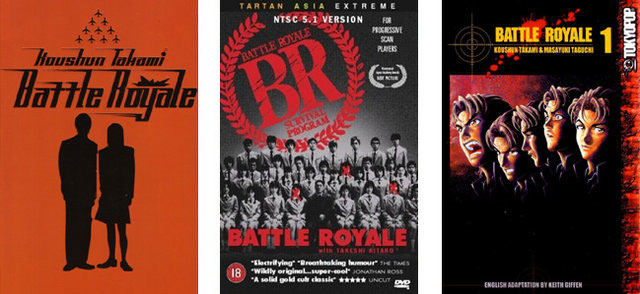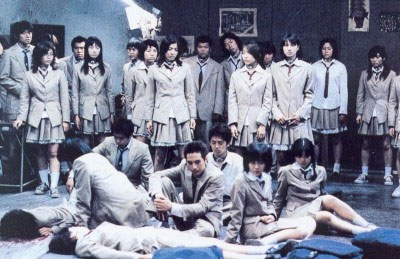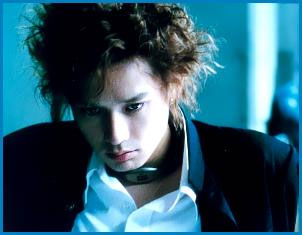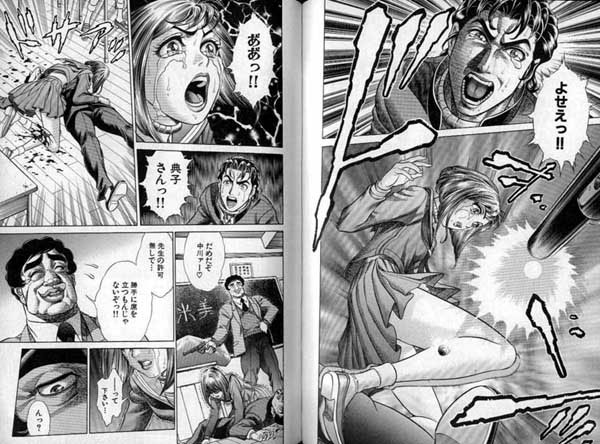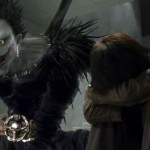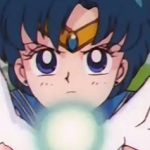For our first three way Adaptation Analysis, I chose a fandom that has not only affected those who read it on an emotional level, but also has crossed over not one, but two mediums in such a way that its very existence is a mainstay of Japanese pop culture. I’m talking about Battle Royale. Also, for those who have never experienced this wonderful story, I will avoid spoiling any character storylines or the survivor lists.
Battle Royale is set in an alternate time line, where Japan is a police state called The Republic of Greater East Asia. In order to hold this police state, “The Program” was created to instill paranoia and fear in the population, thus ensuring absolute control over them. “The Program” takes unsuspecting 3rd year junior high school students (average ages of 14-15), places them on an isolated island, and gives them simple instructions. One person must remain alive at the end of 3 days. If more than one is left alive, they will all die. Each student is strapped with a metal neck band, which is not only a placement indicator, but also a bomb. Attempt to escape, or wander into a “red zone”, and your head will be no more. The students are given food, a “weapon” (if they’re lucky), and a map… and they’re off. The story spans the three days, as childhood friends kill each other out of fear, accident, or just because they don’t care.
The original novel was written by Koushun Takami in 1999. The novel was a critical success but was shunned for its subject matter and excessive violence. The book was essentially a play on the Darwin theory of “survival of the fittest.” Regardless, the popularity of the book made a film adaptation inevitable. In 2000, the film Battle Royale was released to critical acclaim and became a box office smash. The ball had begun rolling, and only two years later, a fifteen part manga series was written (running from 2002 to 2006), which was written by the original author and illustrated by Masayuki Taguchi.
On average, most will admit to having watched the film and potentially reading the book. It would take someone with a much stronger will (and wallet), to tackle the manga alone. As someone who has done all three, I highly recommend it. Not only does this story grow through its mediums, but it comes to a point where one needs all three to full enjoy what this story has to offer.
The bare bones of the story make up the film. Backstories were cut out almost completely or were tossed in with a line or two. Only the major players (i.e. Shuya) get enough screen time to have a back story, as the major focus remains on the current events at hand. For a film, this is acceptable, as too much back story would bog down the action. I will recommend the Director’s Cut, as extra time was placed on characters’ histories (especially Mitsuko’s), and you have a bit more understanding that not only are these kids friends, but they have been friends for many years.
The original book delved into more back story but glazed over identifying the characters with much more than a basic description. This was fully acknowledged by the writer, who wanted the children to be more “statistics” than humans. That concept is evident in all three mediums, which have a body count statistic appearing in each chapter (or in the film’s case, at specific points in the movie).
The death toll remains the same, with survivors and antagonists constant throughout all three versions. Even some of the more iconic battles and deaths remain roughly the same (hatchet to the head, suicides, poison, etc.). Where the manga is a played up version of the book, the film did take liberties with many deaths, either having them off screen, or killing off several quickly rather than the intimate deaths the characters suffered in the book/manga. For the sake of time, this is understandable.
The only major character change was in the origins and motives of Kazou Kiriyama, the lead antagonist of the story. While in all formats, the actions of Kiriyama remain constant (as the one student fully “playing the game”), his motives are entirely different. In the movie, he is a “transfer student” who signs up for only one reason: fun. However, in the book/manga, Kiriyama is a normal student in Class B who suffers from a case of anti-social personality disorder (or, simply put, he’s incapable of any emotion). His choice to “play the game” is decided on a flip of a coin and not for fun. The reason behind his lack of emotion is explained in both the manga and book, but Kiriyama has no back story whatsoever in the movie. Visually speaking, this made the character frightening, as it indicated a 15 year old boy could enjoy killing for fun. Kiriyama also never speaks in the film, while he speaks only when it’s important in the book and manga.
If one were to “rate” the book, movie, and manga based on their content and explicit sex and violence, the ratings might look like these:
Book: Rated R / Movie: Rated PG-13 / Manga: Rated XXX
Though the film is very violent, seasoned film viewers get used to the barrage of CG blood and over the top deaths. Excluding one kill, which causes most men phantom pains, it’s all pretty standard fare. There is no nudity or on screen sex, though aftermath carnage is a given. The book doesn’t focus on the violence, but it is there, and it’s in droves. One can also argue that a person’s imagination is much more visual than any film could be.
However, all bets are off with the manga. Every drop of blood, piece of tissue, and body organ is shown in extreme detail that would make any Saw fan swallow. The art is not your typical “shojo” style. Rather, it has people looking like real people. Not everyone is drop dead gorgeous, much like in the real world. This works for the manga, and makes it very gritty and hard. You see full out nudity (male and female), graphic sex, extreme violence, gore, and rape, and it’s all done with exceptional detail. It takes a strong stomach to make it through all 15 volumes, but it is worth it to see a much more vivid tale than either the book or the film could produce.
In America, it is rare that a film makes a good adaptation from a novel, and it’s even harder for the novelization comic book to be just as faithful or to add more to the story at all. However, the Japanese have it down in this case, and it only makes the story of Battle Royale all the more epic.
Up next! With all hype of Watchmen and all things Alan Moore, I’ll be anaylizing the adaption of the graphic novel V for Vendetta to film.


